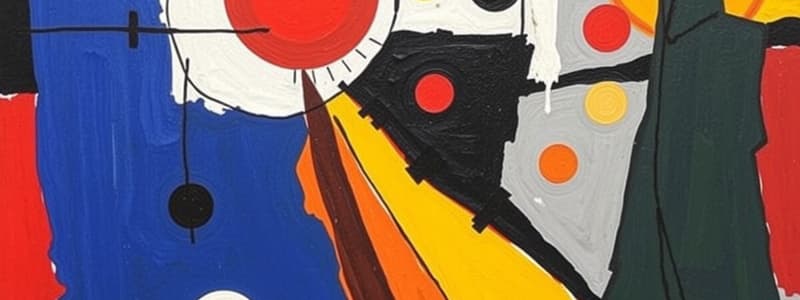Podcast
Questions and Answers
What does the term 'non-objective art' refer to?
What does the term 'non-objective art' refer to?
- Art that depicts realistic subjects from nature.
- Art that is completely abstract and has no reference to the natural world. (correct)
- Art that is focused on historical events and figures.
- Art that uses recognizable images to convey meaning.
Which of the following best describes the concept of content in a work of art?
Which of the following best describes the concept of content in a work of art?
- The emotional, intellectual, and symbolic meanings expressed in the artwork. (correct)
- The arrangement and composition of formal elements.
- The physical materials used to create the artwork.
- The historical context in which the artwork was created.
What does iconography analyze within a work of art?
What does iconography analyze within a work of art?
- The techniques used to create the artwork.
- The cultural context surrounding the creation of the piece.
- The visual imagery and underlying symbolism. (correct)
- The subjective impressions it creates in viewers.
How is 'form' defined in the context of art?
How is 'form' defined in the context of art?
Which form of art focuses on everyday life and familiar subjects?
Which form of art focuses on everyday life and familiar subjects?
Which visual element is primarily focused on the perceived lightness or darkness in a work of art?
Which visual element is primarily focused on the perceived lightness or darkness in a work of art?
What principle of design emphasizes the importance of size relationships among various elements in a composition?
What principle of design emphasizes the importance of size relationships among various elements in a composition?
Which term best describes the specific methods in which a medium is applied by an artist?
Which term best describes the specific methods in which a medium is applied by an artist?
Which of the following is NOT considered a visual element of art?
Which of the following is NOT considered a visual element of art?
In art, what does the term 'style' refer to?
In art, what does the term 'style' refer to?
Flashcards are hidden until you start studying
Study Notes
Objects and Events in Art
- Represents the elements illustrated in a work of art, such as people, places, and ideas.
- Examples can include occurrences within genres, like religious or historical themes.
Genres
- Classification systems for art based on subject matter or form.
- Types of genres include religious, mythological, historical, portraits, still life, landscape, non-objective art, and genre subjects depicting everyday life.
- Wassily Kandinsky’s "Composition VII" (1913) exemplifies abstract expressionism and non-objective art.
Non-Objective Art
- Defined as completely abstract, lacking representation of the natural world.
- Focuses on visual elements without direct connection to identifiable objects or scenes.
- Wassily Kandinsky is recognized for his pioneering work in non-objective art.
Content
- Refers to what the artwork expresses or conveys, essentially answering "what is it about?"
- Encompasses emotional, intellectual, psychological, and symbolic elements that contribute to the artwork’s meaning.
- Examines cultural and symbolic reasons behind the artwork’s creation.
Form
- Relates to the composition or design elements of art, covering arrangement and structure.
- Considers the overall appearance, materials used, and the accompanying style of the work.
- Fundamental in understanding how the art is crafted and perceived.
Iconography
- The study of visual images or symbols in art, involving interpretation of subject matter.
- Involves analyzing imagery to uncover deeper meanings beyond surface appearances.
- Symbolic interpretations can be culture-specific, meaning that recognizable symbols may not hold the same significance across different cultures (e.g., the cross in Christianity).
Visual Elements of Art
- Line: The path created by a moving point, used to define shapes and convey movement.
- Value: The lightness or darkness of a color, crucial for creating depth and contrast.
- Shape: Two-dimensional areas defined by lines or color, can be geometric or organic.
- Color: Composed of hue, saturation, and brightness, evokes emotions and sets the mood.
- Texture: The surface quality of an artwork, can be actual (tactile) or implied (visual).
- Space: The area around, above, below, or within objects, contributes to composition and perspective.
- Time: In art, refers to the duration depicted or implied, often seen in moving images or sequential art forms.
- Motion: The illusion of movement within artwork, often achieved through techniques like blurring or dynamic lines.
Principles of Design
- Composition: The arrangement of visual elements within a work, impacting overall effectiveness and aesthetics.
- Unity: The harmonious interaction between elements, creating a cohesive whole that feels complete.
- Variety: Introduction of differing elements to maintain interest and engage viewers.
- Balance: The distribution of visual weight within a composition, can be symmetrical, asymmetrical, or radial.
- Emphasis (Focal Point): The area within an artwork that draws attention, often achieved through contrast or positioning.
- Rhythm: A visual tempo or beat created by repeated patterns, colors, shapes, or lines, guiding the viewer’s eye.
- Scale: The perceived size of an object in relation to other elements or the artwork as a whole.
- Proportion: The relationship of sizes between different parts of an artwork, crucial for realism and coherence.
Medium
- Refers to the materials and tools utilized to create art, including:
- Paint (oil, acrylic, watercolor)
- Drawing materials (charcoal, pencil, ink)
- Sculpture materials (marble, bronze, clay)
Technique
- Specific methods and practices for utilizing art mediums, reflecting the artist's skill and intention.
- Techniques can range from traditional methods to experimental approaches, influencing the artwork's final appearance.
Style
- The unique expression characterized by the artist's way of handling materials and visual elements.
- Distinctive traits can be associated with individual artists, specific art movements (e.g., Impressionism, Pop Art), or cultural periods.
Studying That Suits You
Use AI to generate personalized quizzes and flashcards to suit your learning preferences.


